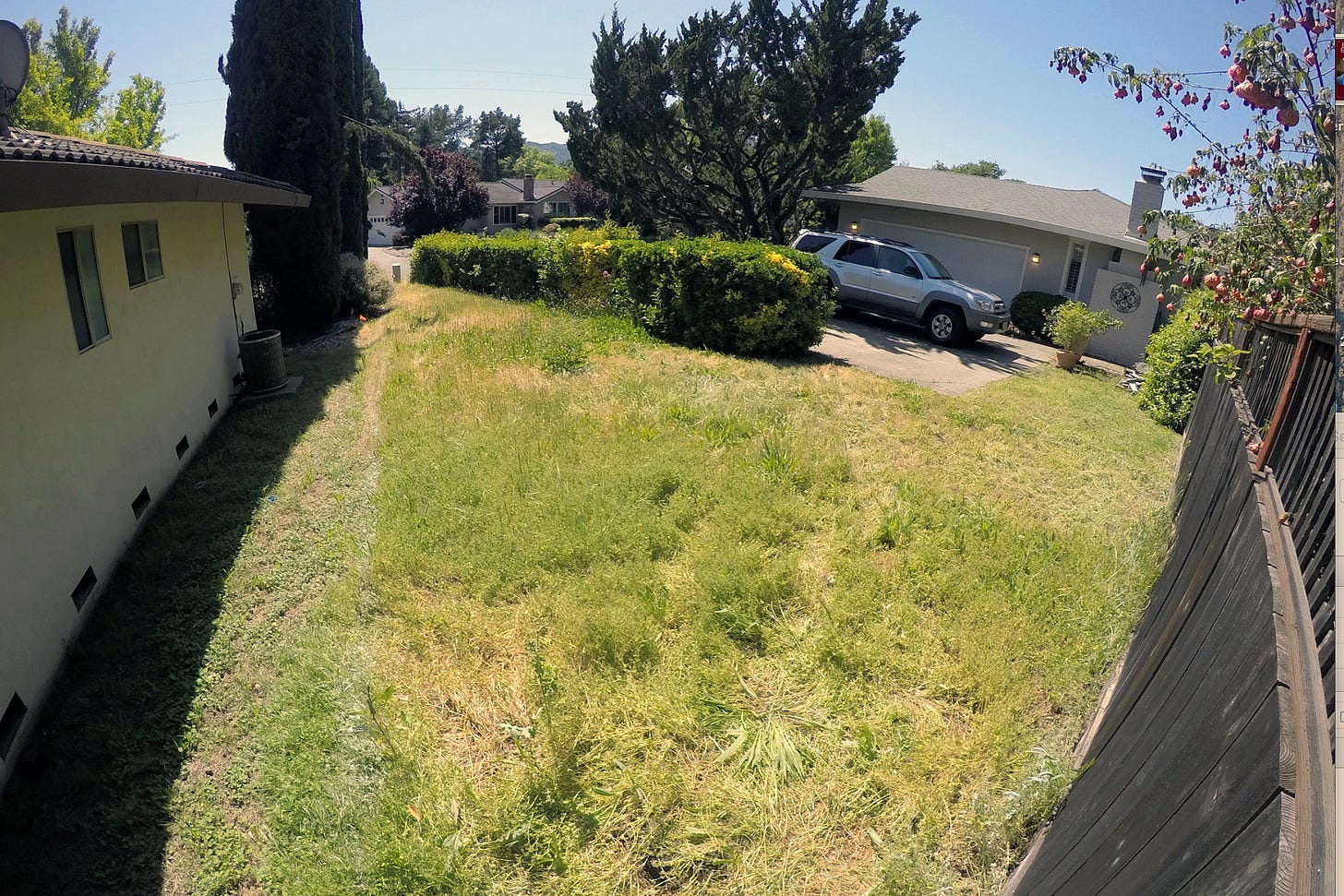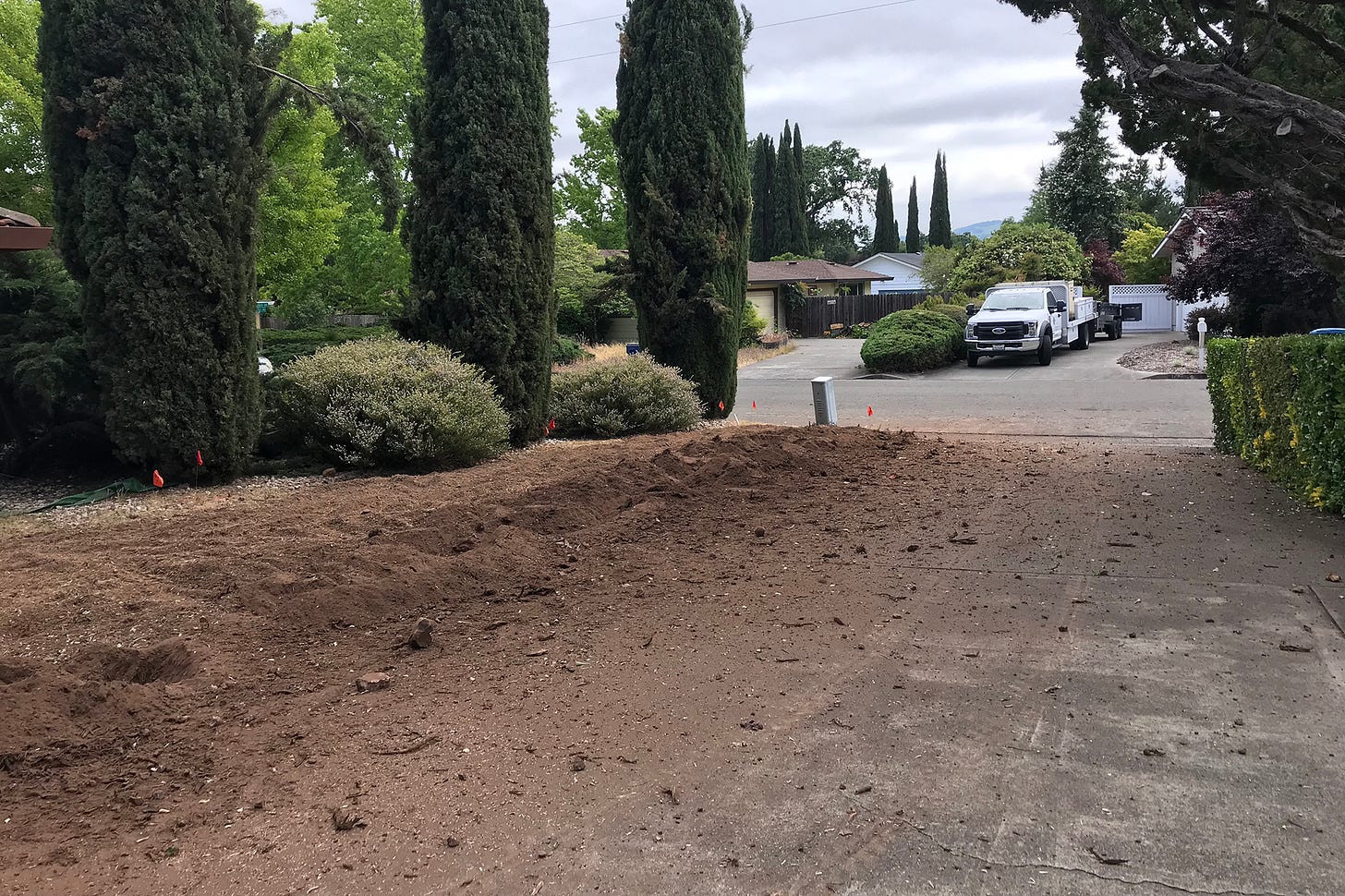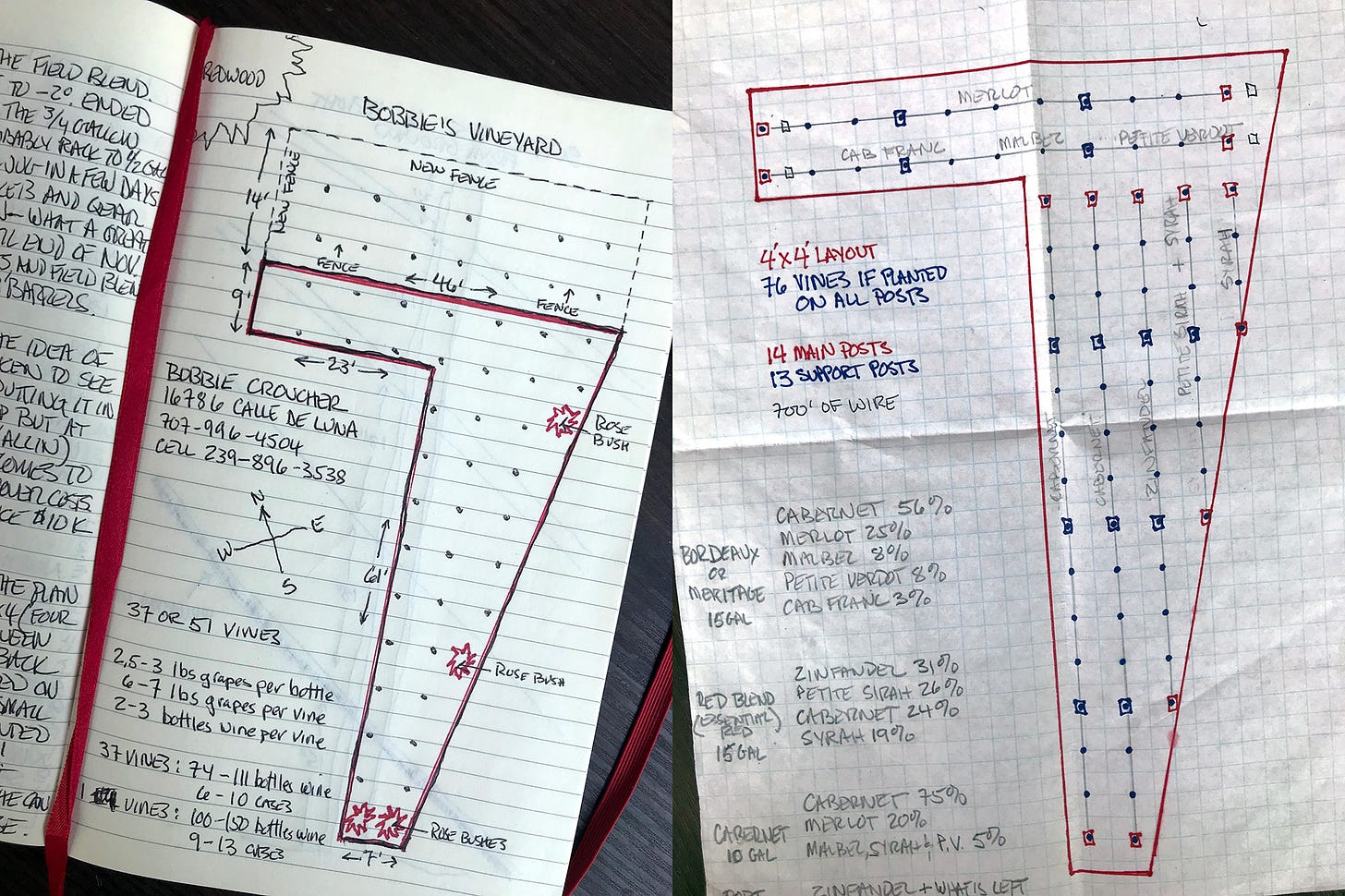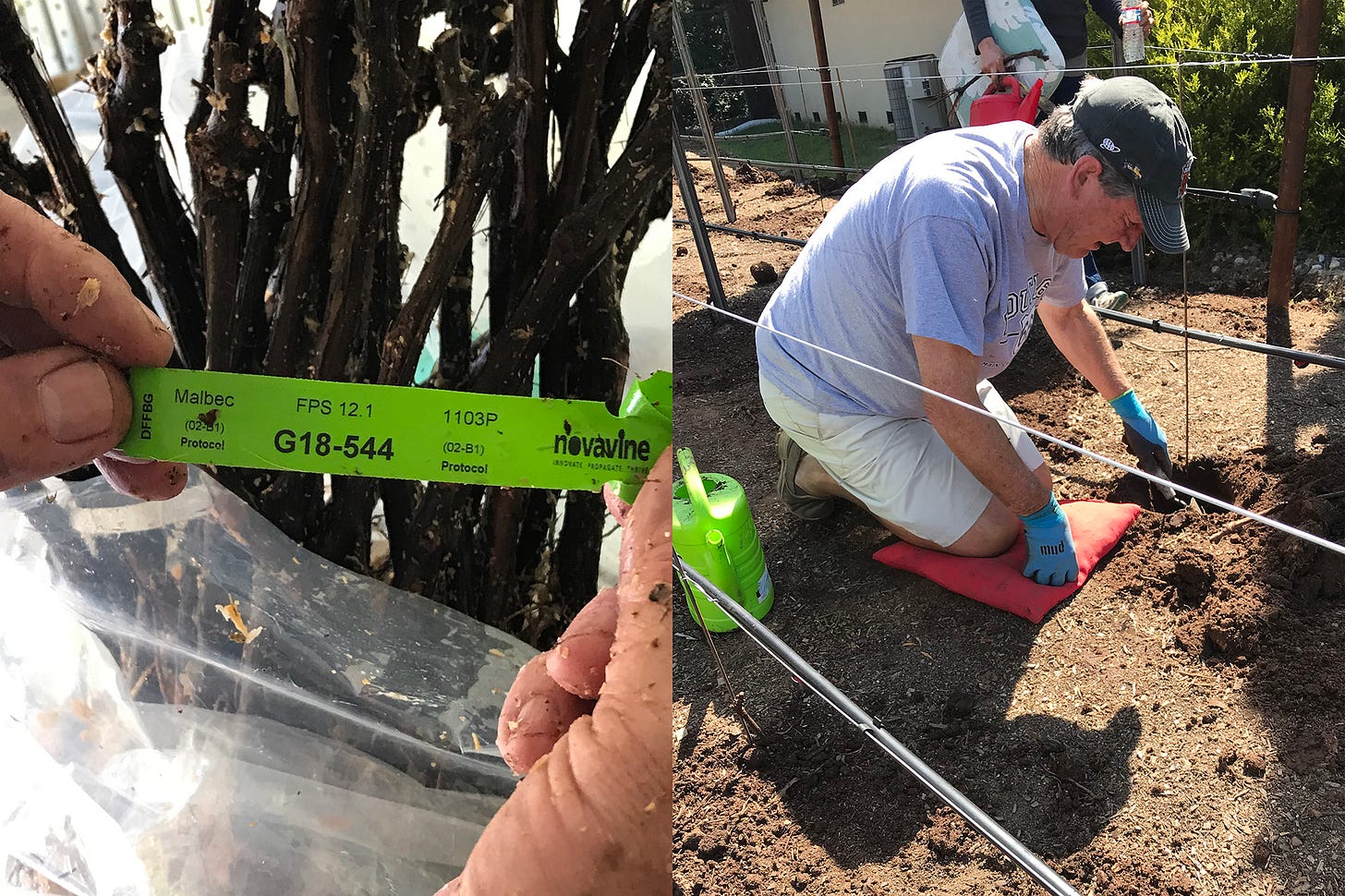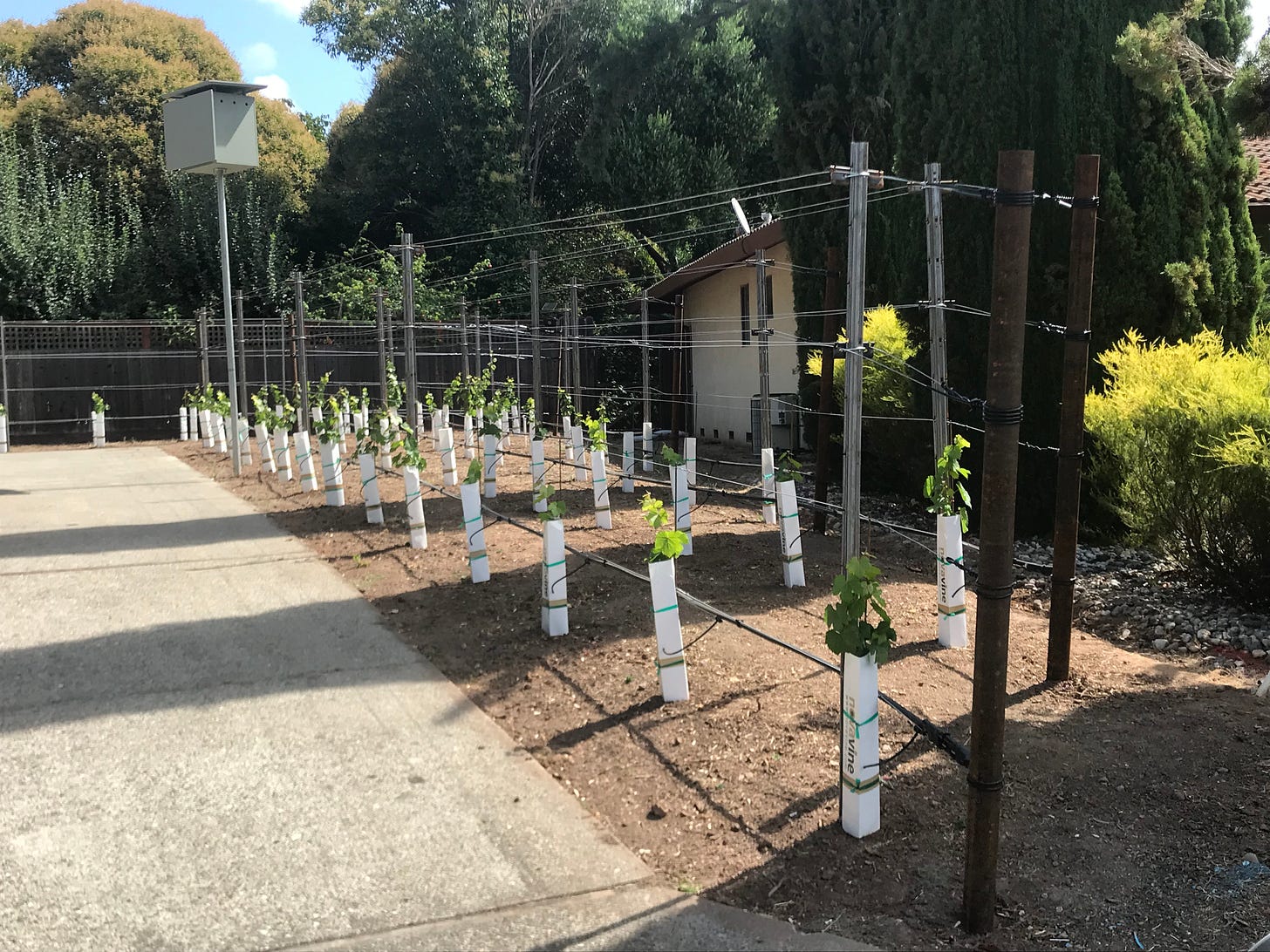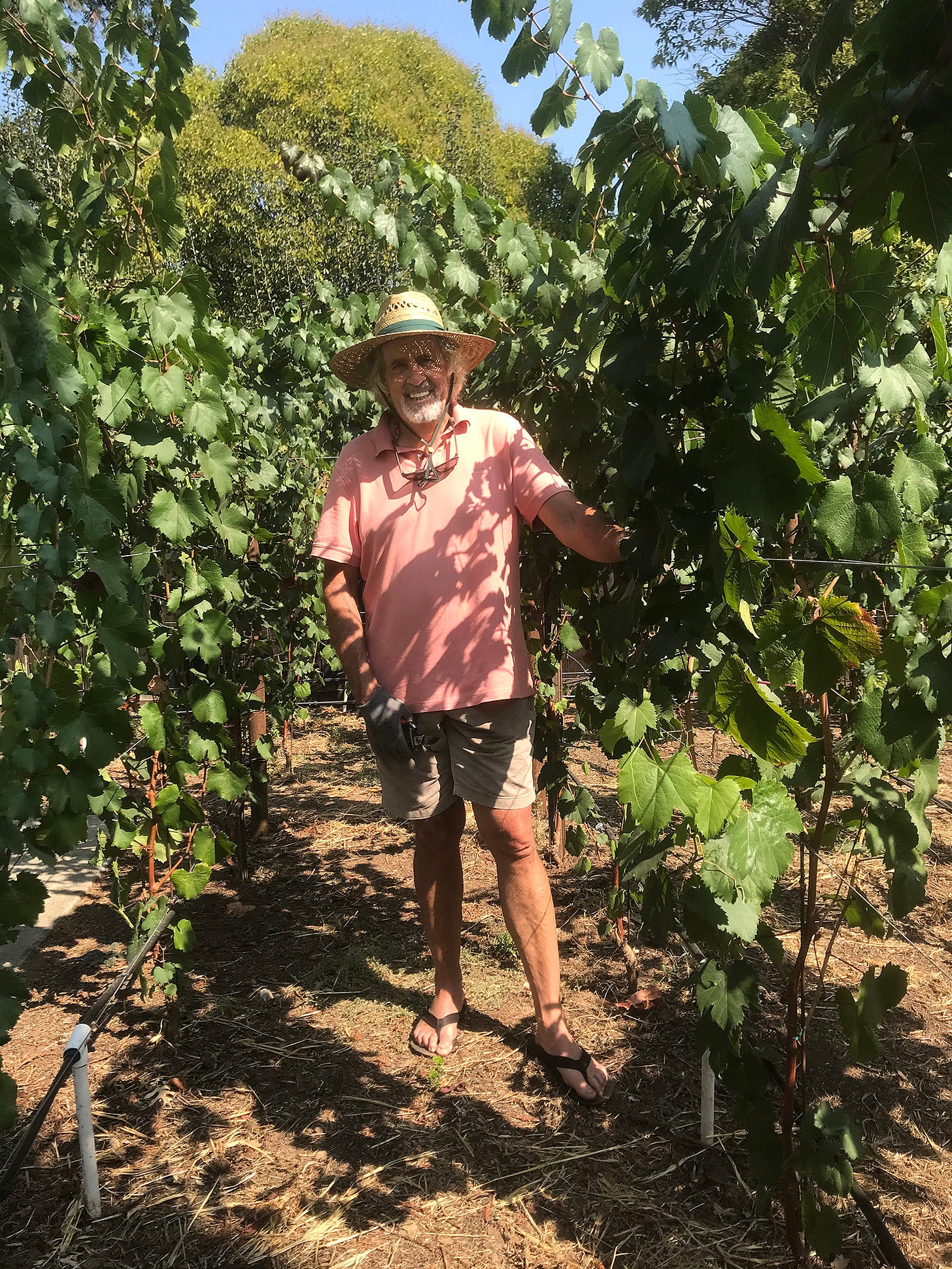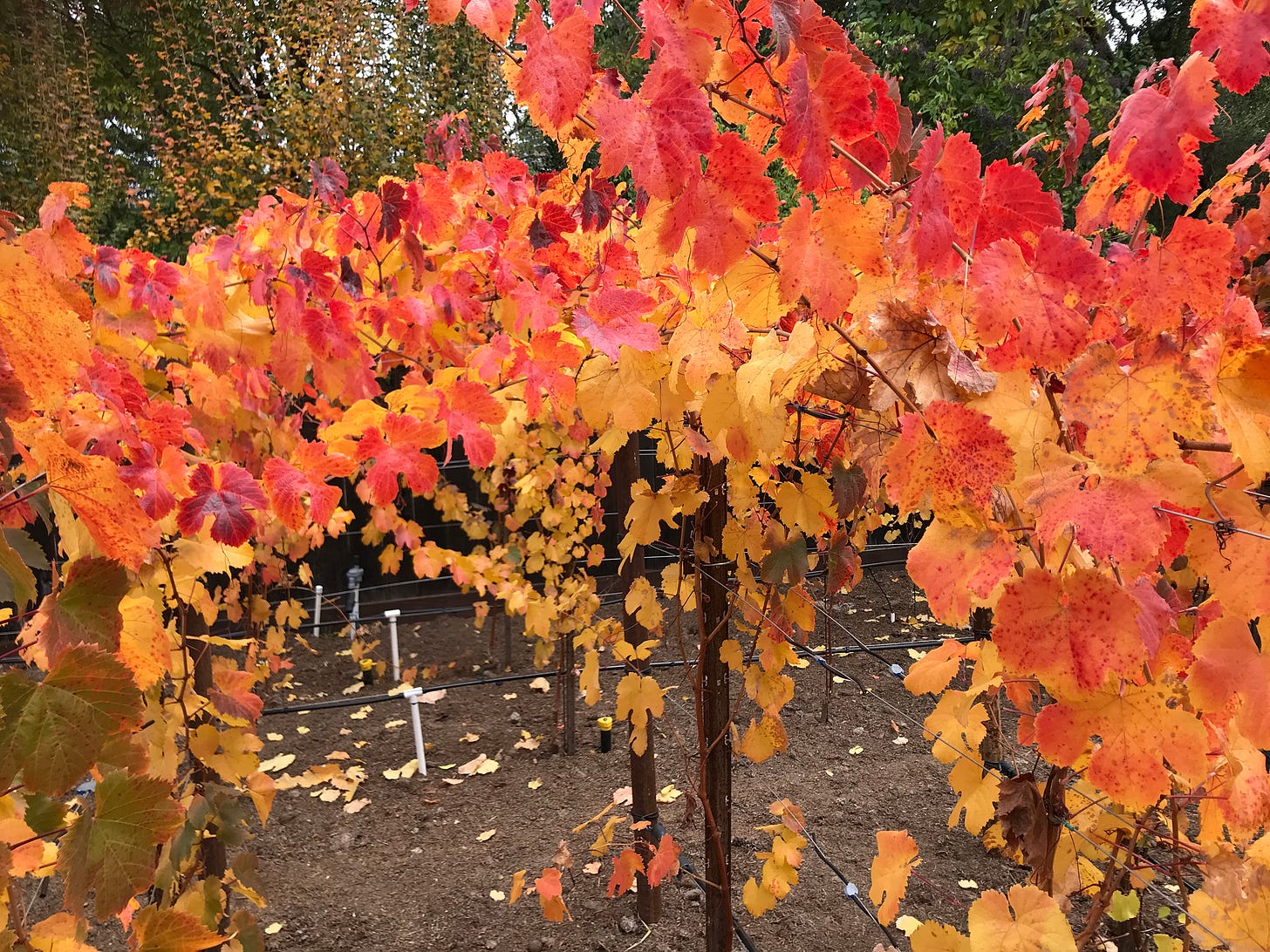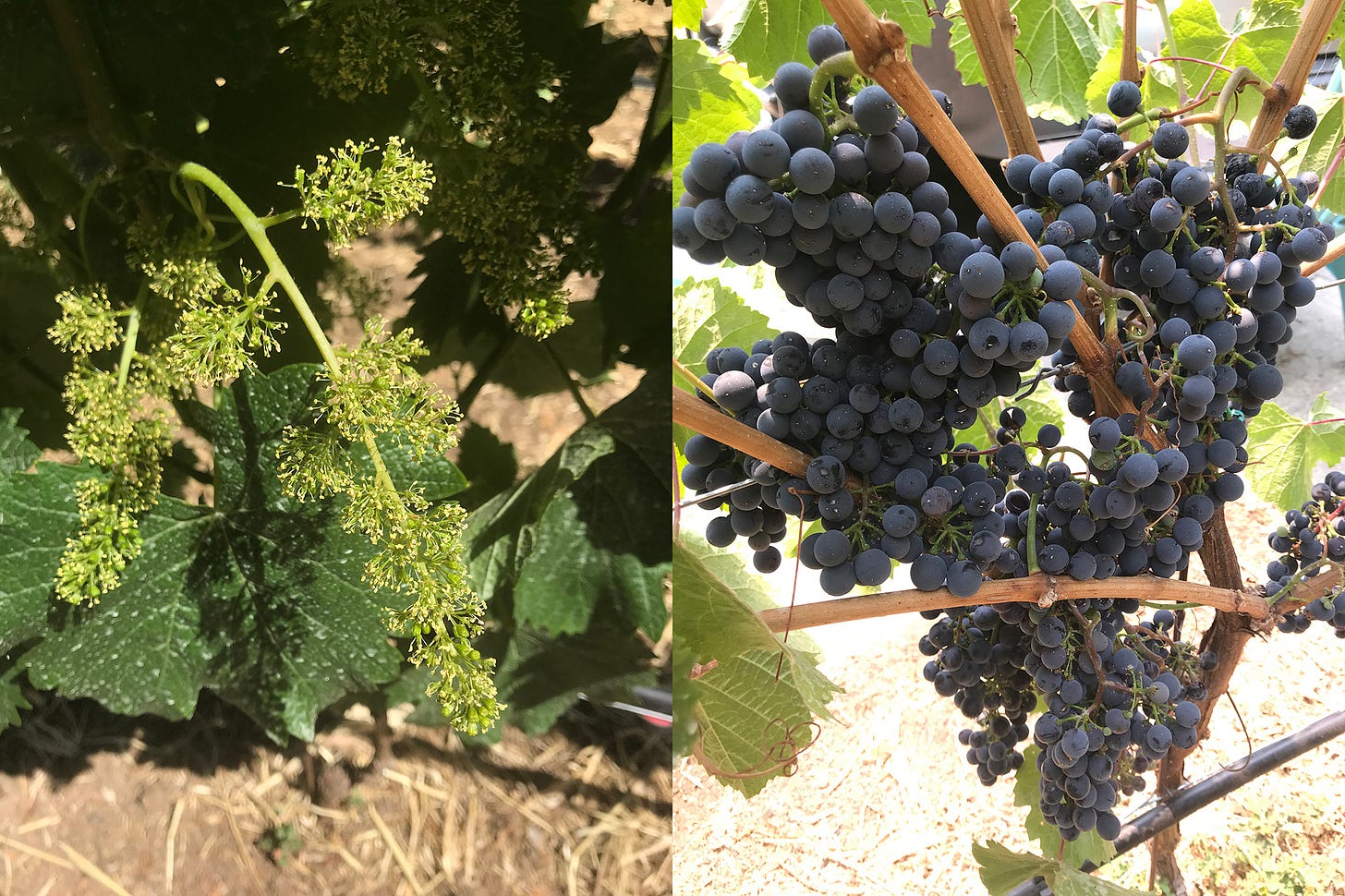Bobbie's Vineyard
And my salvation
Wine had to be grapes first. Diamonds had to be rocks first. Butterflies had to be caterpillars first. Rainbows had to be storms first. ― Matshona Dhliwayo
Studying wine taught me that there was a very big difference between soil and dirt: dirt is to soil what zombies are to humans. Soil is full of life, while dirt is devoid of it. ― Olivier Magny
Don’t look a gift horse in the mouth
A little over two years ago I constructed and planted a tiny vineyard of Malbec vines in Sonoma, arguably the epicenter of viticulture in America. I was, at the time, a recent transplant from Colorado. I had as much experience with grapes as I had with grapefruit. That is to say, very elementary. I knew that they tasted quite good, and most of them had seeds. One grew on a vine and the other a tree. You could make wine from grapes, and excellent cocktails from grapefruit juice. Oh, and you should avoid grapefruit juice if you are taking certain medications, but you should drink lots of wine because it is a medication. That’s all I knew.
However, I had just made a movie about home winemaking that included a clip on how to construct and plant a small vineyard. That roughly six-minute sequence came from literally hours of footage I shot, all while watching with keen interest just how it was being done. Here’s the finished sequence as it appeared in my movie Tiny Vineyards. It’s narrated by Ken Wornick, who with his business partner Anastacio Enriquez were the folks that built the vineyard. This is pure soul craft—hard, righteous, get-your-hands-dirty work. And I really wanted to do it!
Of course, with the price of land in the stratosphere in and around Sonoma, it’s not like you could just buy a vacant lot and plant a few vines. I needed to find someone who had a backyard or a front or side yard with some space, and who wanted a vineyard. Not such a big ask—I convinced myself—considering where we where. And, as it worked out, it wasn’t.
Sometime in the late fall of 2018 I was invited to a picnic on the grounds of the Buena Vista Winery—California’s and Sonoma’s oldest— overlooking a beautiful vineyard in resplendent fall colors. The hosts were pals of my friend Deb and the other guests were acquaintances she had met through them over the years. Among the group was an attractive woman with a hearty laugh and sharp, attentive eyes. She was a not-too-recent widow who had lost her last husband—the true love of her life—in a tragic helicopter accident. Yet, despite that sadness in her life, and having reached the age where social discourse (even at picnics) requires a requisite debriefing of everything that ails you, I sensed that she still seethed with a vibrant life force. “I don’t feel my age at all,” she would later tell me. “I’m still a wild child inside, only slightly tamed down.”
I liked her immediately.
Her name was Bobbie and she struck up a conversation. She’d heard about the Tiny Vineyards movie I was making and wanted to know all about boutique vineyards. “You know, I’ve always wanted a small vineyard ever since I moved to Sonoma. And I have just the space for one of those in my yard.”
Yep, you and everyone else lady. But you have no idea of the commitment it will take.
I just smiled and nodded in agreement. Then, like the card shark she actually is (seriously, casino blackjack tournaments!)—she played her hand.
“Well, why don’t you build one for me, seeing how you’re now an expert with the movie and all. I’ll pay for everything, you do the work, and we’ll split the wine.”
Whoa! Did an incredible opportunity just land in my lap?! But what do I know about building a vineyard? I couldn’t possibly… but, then again, how hard could it be?
As Horace, the ancient Roman poet, was fond of extolling, and modern overachievers quick to adopt, “Carpe diem!” Or as my dad just as tirelessly lectured, “Where there’s a will, there’s a way.” But it was W.C. Fields who actually came to mind that day at the picnic, sealing my fate (and Bobbie’s) with another one of his truisms: “If you can't dazzle them with brilliance, baffle them with bullshit.”
“Yeah, sure. I could do that. No problem.”
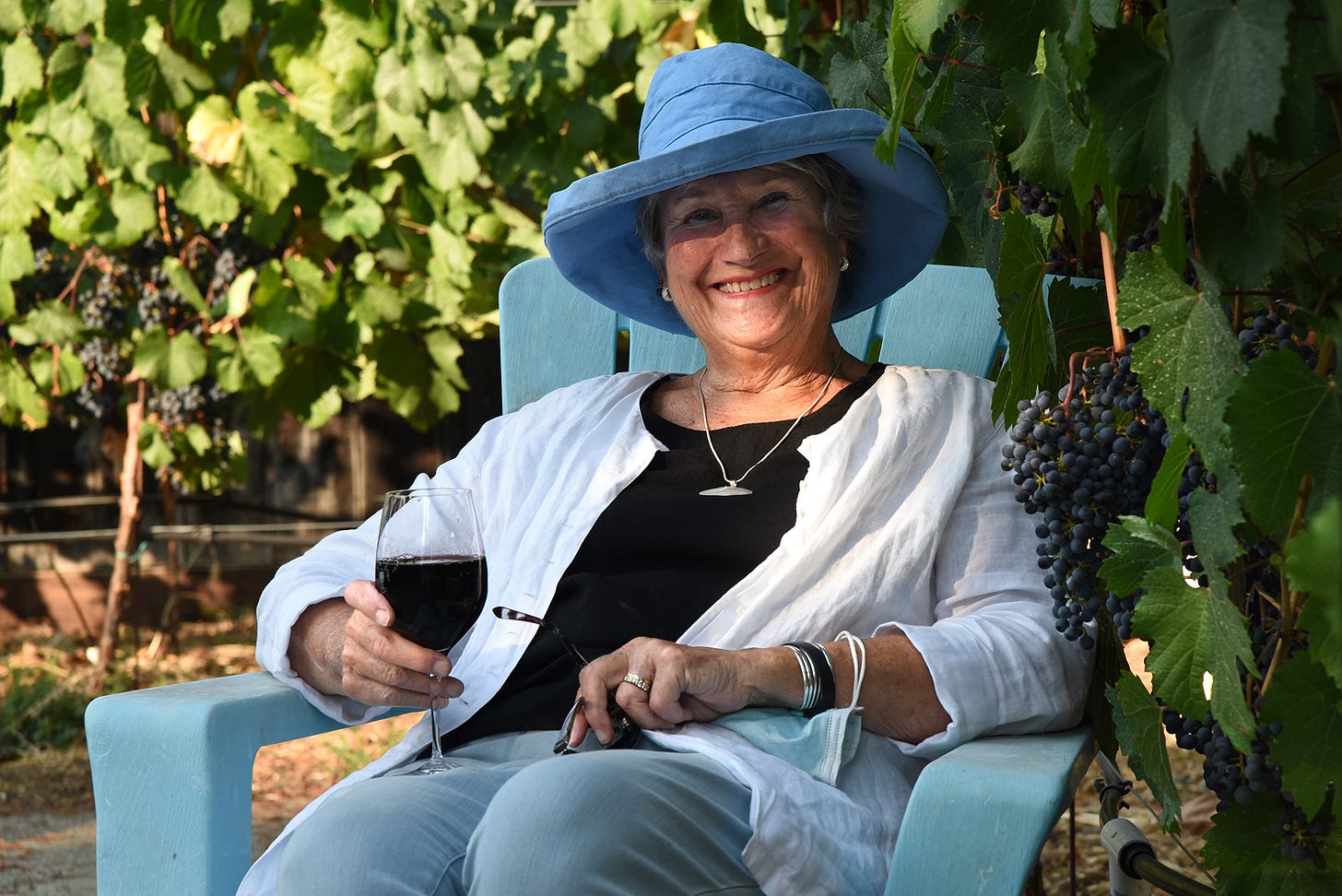
A great partnership
Bobbie and I reached a simple agreement. A good one I think, inasmuch as we’re both still comfortable with it despite the inevitable little changes that occur when real life happens. It covered the construction of a small vineyard in her side yard, and then went on to include a small garden-shed winery (watch for an upcoming newsletter about this) and all the specifics for making and sharing wine. The glue that holds this all together is that Bobbie really wanted a private vineyard and the bragging rights that go along with making your own wine, and I really wanted the viticulture experience of building and nurturing a vineyard, and desperately needed more space to make wine than Deb’s laundry room could afford. Okay, I wanted the bragging rights too.
We both wanted the wine.
The area Bobbie had in mind for her vineyard was an unused, weedy side yard parcel that extended through the front yard on the south side of her house. It was an “L” shape that wrapped her driveway and was bordered on one side by a large hedge, shadowed at the back by a giant redwood and ghosted on the front edge by three large oriental cedars that technically belonged to her neighbor. It was everything a vineyard didn’t want to spring from, but Bobbie wasn’t deterred.
In no time she had ripped out the hedge and rototilled the roughly 1,600 square feet we had to work with. It was clear, even then, that we were dealing with some good soil and some bad dirt. There were chards of charcoal in one spot where a fire had been built, probably to burn brush, and two areas had evidence of extensive evergreen needles composting over the years. That foretold the possibility of very acidic soil.
Early on I set up a time-lapse camera on the southeast corner of where the vineyard was to be built (that’s the angle from the top photograph above) to document progress. It snapped six photographs a day for almost two years, and once I had stitched the photographs (a single image from the same time every day) into the video below it provided a remarkable visual diary of a tiny vineyard coming to life and going through the annual seasons.
When a commercial winery decides to build a new vineyard there are all sorts of considerations that go into realizing that goal. Where to build it geographically, how big is it going to be, what is the micro-weather at the site, what is the soil like, what kind of access to water does it have, how does the sun track and how should the rows be aligned, what varietal to plant and what kind of yield is desired, what trellis system will be used and how far apart will the vines and rows be spaced, how will it be farmed… the list goes on and on.
When a private homeowner decides to put in a tiny vineyard the answers to most of those questions are preordained. You get what you got. Maybe there’s a little wiggle room in how you lay out the rows to align with the sun—east to west or north to south—but the reality is that aesthetic considerations probably play a larger role. How is this vineyard going to look from the street or from the back patio? Questions of variety, yield, cost and size are the next deciding factors, as every home winemaker wants to grow as many grapes as possible of their favorite varietal without busting the bank or becoming a labor slave to the vineyard.
Bobbie and I were no different, and by the time we had drawn out several ambitious plans we settled on a relatively simple “L” shaped design of 64 vines, spaced four feet apart, trellised in two directions (for simplicity and looks) wrapping her driveway. As for the varietal, I am a Malbec aficionado and had been dropping hints and plotting to turn Bobbie into one as well. By serendipity, just as we were bumping up against our plant-order deadline, Bobbie had an apparent out-of-body experience with a bottle of Malbec at one of her wine-tasting haunts and was all atwitter about how good it was.
“What do you think about Malbec? Maybe that’s what we should grow.”
I was down with that!
So I called Novavine Backyard (where all the hipster home viticulturists get their vines!) and ordered 72 one-year-old dormant field-finished Malbec bench grafts, which basically looked like one-foot-long old dead sticks with spindly roots on one end and a graft knot on the other. They were clone FPS 12.1 (high vigor, high yield) from Pointe de la Maye, France, grafted to rootstock 1103P (medium drought resistance, high phylloxera resistance). You don’t really “order” vines from Nova Backyard; rather, you buy leftover inventory from orders produced for the big commercial vineyards. So it’s not like I had any great choice, or even any real understanding of all the stated attributes, but I had dibs on six dozen genuine Malbec vines, which I asked Nova to hold for us for a month or so while we got down to constructing our vineyard.

If you build it they will come
Rather than describe it in agonizing (at the time and now at the telling) detail, please take six minutes and watch the video near the top of this page documenting a small vineyard construction. We did it EXACTLY like they did. What else did I have to go on?!
Bobbie’s gardener, Juan, had an impossibly strong helper with the improbable name of José del Toro. Being two Joes we bonded instantly, and I sort of poached him away from Juan for a few days to help me with the vineyard construction. He was a godsend when it came to manually pounding in the end posts and stringing the heavy high-tensile trellis wire that required hands of steel to twist.
Once the vineyard infrastructure was in place the planting began, which meant digging 64 holes and positioning bench grafts in them at exactly the right height. Bobbie’s friends Dave (top right) and Lynn, and the ever-productive Deb, did the lion’s share of that repetitive, back-twisting work. When everything was finally in the ground we came back through and affixed a plant protector over each “stick.” We finished on June 15th. Bobbie installed a barn owl nesting box on a pole at the edge of the vineyard with the promise of natural pest control if we could just attract a pair of owls in the market for real estate. So far no takers.
Then it was twice-weekly watering and a lot of hurry-up-and-wait as the dormant grafts woke up and began pushing new growth. Impossibly, just a month later new green leaves appeared over the top of the plant protectors and we celebrated the birth of a vineyard! Deb and I took off to Argentina to chase a total eclipse and check out the Malbec scene in Mendoza (story to come), and when we returned two weeks later some of our new vines were already approaching the top wire.
That first summer we just let everything grow as it would, and when winter came and the vines sank once again into dormancy I pruned everything back to a single two-inch cane with two buds. It sort of felt like we were starting over again. I couldn’t have been more wrong.
The summer of 2020 was an explosion of growth in Bobbie’s vineyard with vines sending out 15-foot canes in all directions. Off came the plant protectors and we concentrated on maximizing root and vine growth, looking for the hardiest of canes on each vine that might serve as a trunk the next season. The vineyard got a lot of attention that year as there was little else any of us could do in that strange time of pandemic lockdown.
When fall arrived we were treated to the unexpected bonus of the vineyard in full autumn splendor. Oftentimes spotty or individual vine red leaf color signifies a fungus or some other vineyard disease, but this magnificent display was throughout the vineyard on every leaf. Most likely just a characteristic of the particular clone we had planted. Lucky us!
These are the times that try men's souls
The winter of ’20/’21 was a time that tested everyone’s soul. A deadly virus stalked around the planet and the natural order of things seemed out of whack. People sickened and died, fires raged across the land, and climate anomalies tested the cycles of time. Yet plants grew and wildlife took to the streets like silent protestors of an ancient injustice. Was this the beginning of the end of man, a harbinger of the loss of hierarchy in the chain of life? Such dark thoughts haunted me during that time and only the zen of quiet, repetitive work in the vineyard could assuage my anxiety.
At the first sign of rain I planted a cover crop of of bell beans, fava beans, magnus peas, dundale peas, common vetch, barley and oats between the rows of vines in Bobbie’s vineyard. We would till this under in early spring, providing excellent nitrogen fixing and rich organic matter. In mid-February I pruned the vineyard, pulling down the long canes on each vine and lopping off all but the best candidate for the trunk, which I left at the height of the fruiting wire.
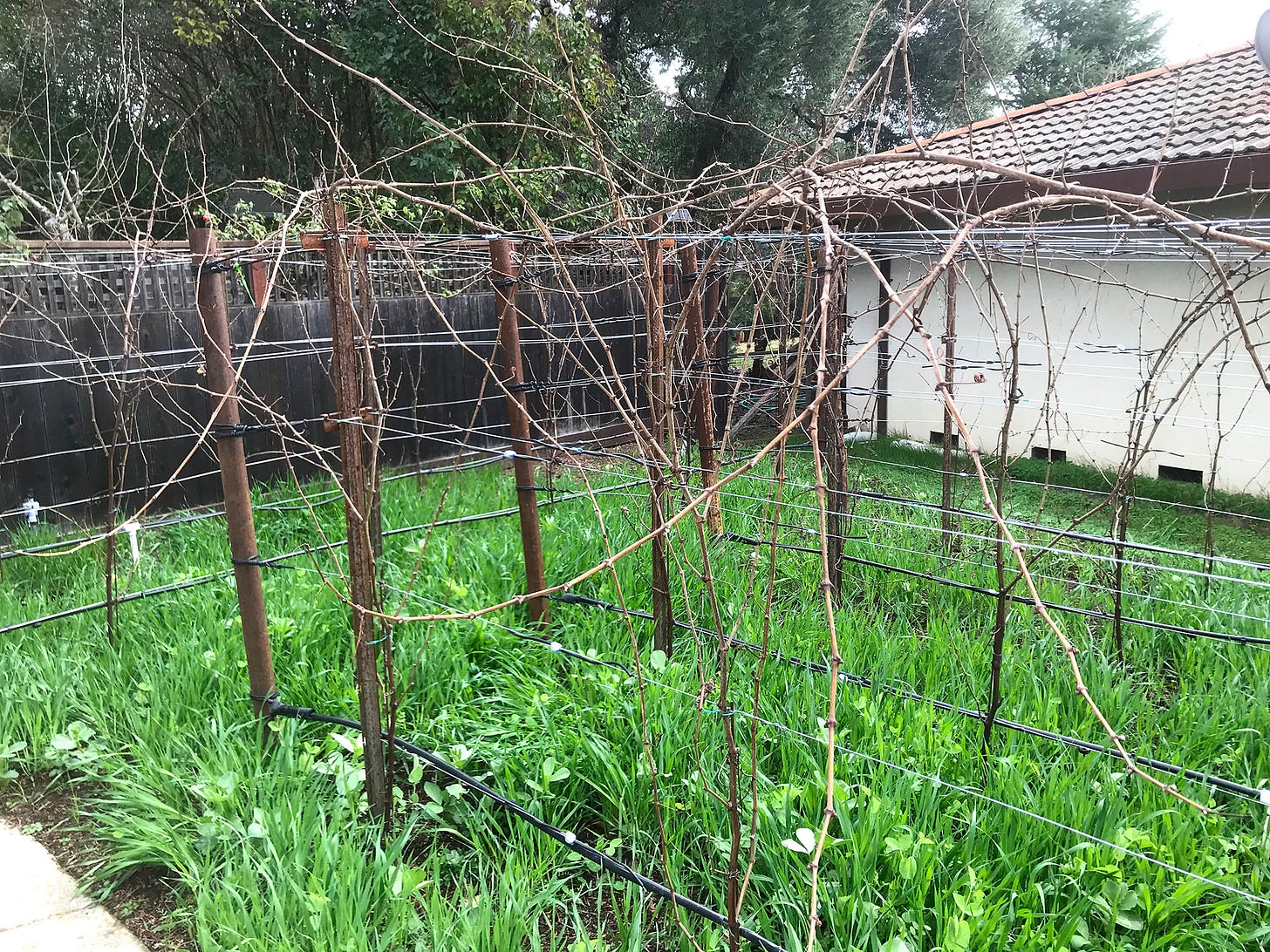
The following spring the same magic happened, only this time I was ready for it. As the buds opened on the single trunk cane I had prepared I suckered off all but four that were in good positions to form a right and a left cordon (arm). I let these grow straight up, and lo and behold each one sent out a couple of very healthy-looking flower clusters. It’s certainly not uncommon for vines to produce a little bit of fruit at this stage but the standard practice is to drop that fruit and concentrate on growing the future cordons.
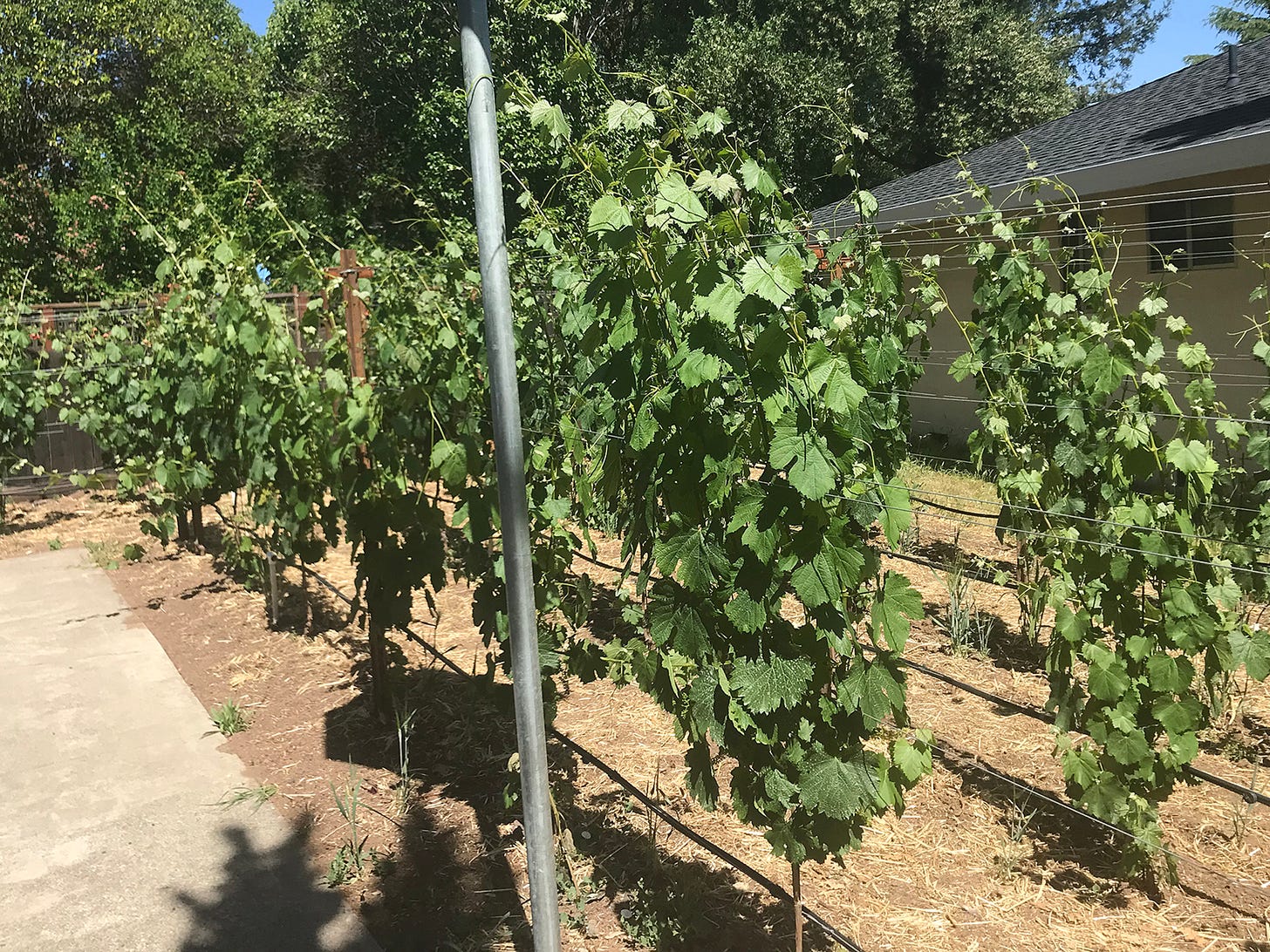
A few weeks later those flowers were grapes and there was no stopping Bobbie. She was beside herself at the prospect of a harvest, nodding her head yes but not buying into it as I explained how they probably wouldn’t be very good grapes and the wine they made would be subpar. “Yeah, but what if we just made a little bit of wine, a couple of bottles for each of us? I know it might not be the best this first time around but it’ll feel awful good to make it.”
As the grapes go through veraison and turn plump and dark purple it is hard to argue with her reasoning. These are very vigorous vines we have raised and right now there are maybe enough grapes—if the birds don’t beat us to them—to make 10 to 15 gallons of wine. Just the act of doing that feels very liberating somehow, and might help reset my mental trajectory as we all navigate this next stage of the new normal.


